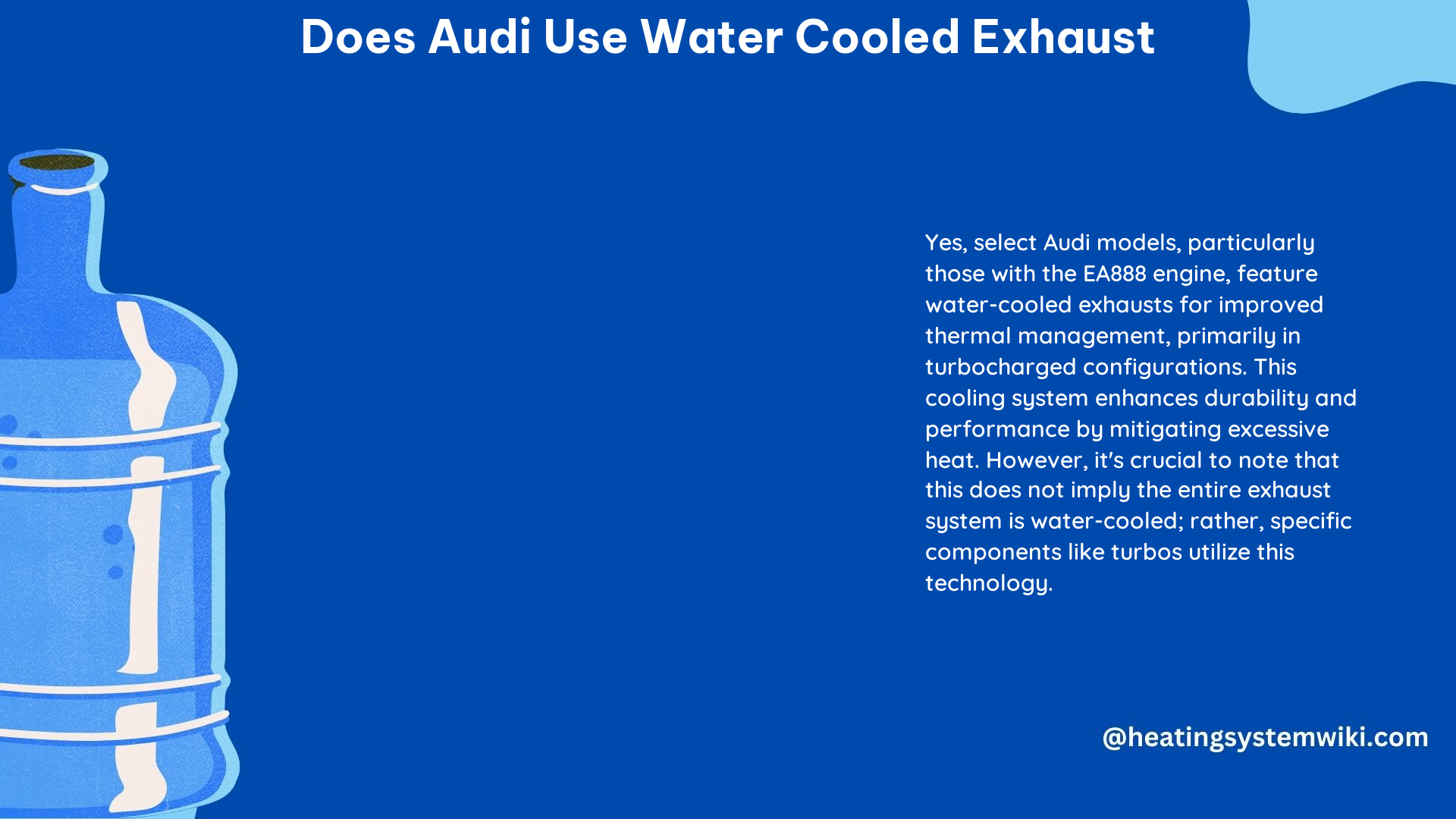Audi, along with other brands in the Volkswagen Group, utilizes water cooling in some of its engines, including the EA888 setup, to manage exhaust gas temperatures and enhance engine performance. This water-cooled exhaust system is designed to improve cold starts, reduce engine wear, and boost fuel economy by allowing for colder air to enter the turbocharger. The system is compact and seamlessly integrated into the engine design, providing benefits such as enhanced heat management, faster cabin warming, and increased turbocharger efficiency.
Audi’s Water-Cooled Exhaust System
Audi’s water-cooled exhaust system is a sophisticated and integrated solution that helps to manage the high temperatures generated by the engine’s turbocharger. The system works by circulating coolant through the exhaust manifold and turbocharger housing, effectively dissipating the heat generated during operation.
Key Components of the System
- Exhaust Manifold: The exhaust manifold is designed with internal water passages that allow coolant to flow through and absorb heat from the exhaust gases.
- Turbocharger Housing: The turbocharger housing is also equipped with water-cooling channels, ensuring that the hot components of the turbocharger are effectively cooled.
- Coolant Pump and Hoses: The water-cooling system is powered by a dedicated coolant pump that circulates the coolant through the exhaust manifold and turbocharger housing. High-quality hoses are used to connect these components and ensure efficient heat transfer.
- Coolant Reservoir: The coolant reservoir stores the engine’s coolant and maintains the proper fluid level for the water-cooled exhaust system.
- Thermostat: A thermostat is integrated into the system to regulate the coolant temperature, ensuring that the exhaust components are maintained within the optimal operating range.
Benefits of Audi’s Water-Cooled Exhaust System
- Improved Cold Starts: The water-cooled exhaust system helps to reduce the time required for the engine to reach its optimal operating temperature, resulting in improved cold-start performance and reduced emissions.
- Reduced Engine Wear: By effectively managing the exhaust gas temperatures, the water-cooled system helps to minimize thermal stress on the engine components, leading to increased longevity and reduced maintenance requirements.
- Enhanced Fuel Economy: The ability to maintain lower exhaust gas temperatures allows for more efficient combustion, which can translate to improved fuel economy and reduced emissions.
- Increased Turbocharger Efficiency: The water-cooling of the turbocharger housing helps to maintain optimal operating temperatures, which can lead to improved turbocharger response and increased power output.
- Faster Cabin Warming: The water-cooled exhaust system can also contribute to faster cabin heating, as the coolant circulating through the system can be used to warm the cabin more efficiently.
Audi’s B9 2.9T Engine and Air-to-Water Intercooler

In the case of Audi’s B9 2.9T engine, the company has opted for an air-to-water intercooler setup, which offers several advantages in terms of packaging and cooling efficiency.
Air-to-Water Intercooler Advantages
- Compact Packaging: The air-to-water intercooler design allows for a more compact and integrated engine layout, as the intercooler can be positioned closer to the turbocharger and engine.
- Improved Cooling Efficiency: The water-based cooling system of the intercooler is generally more efficient at dissipating heat compared to traditional air-to-air intercoolers, leading to better overall cooling performance.
- Reduced Intake Air Temperatures: The air-to-water intercooler setup helps to further reduce the intake air temperatures, which can result in improved combustion efficiency and increased power output.
Ensuring Turbocharger Longevity
It is important to note that while water cooling can help manage exhaust gas temperatures, it does not eliminate the need for proper cooling-down procedures for turbos. As mentioned in the sources, it is still recommended to allow turbos to cool down after hard runs before shutting down the engine, regardless of their cooling method.
Conclusion
Audi’s use of water cooling in its exhaust systems represents a significant advancement in engine technology. By effectively managing exhaust gas temperatures, Audi is able to improve cold starts, reduce engine wear, and enhance fuel economy. The air-to-water intercooler setup in the B9 2.9T engine further demonstrates Audi’s commitment to optimizing engine performance and efficiency.
While water cooling does not eliminate the need for proper cooling-down procedures, it does offer a more efficient and integrated solution for managing exhaust gas temperatures in modern engines. As Audi continues to push the boundaries of engine design, the water-cooled exhaust system is likely to play an increasingly important role in the brand’s pursuit of enhanced performance and sustainability.
Reference:
– Audizine Forum Thread on Water-Cooled Turbos
– Motor Authority Article on Volkswagen’s Water-Cooled Exhaust
– YouTube Video on Audi’s Water-Cooled Exhaust
– Audiworld Forum Discussion on Water-Cooled Turbos
– VW Club Forum Thread on Water-Cooled Exhaust
